Business Law and Ethics: Case Study Report Analysis
VerifiedAdded on 2022/12/27
|13
|2882
|23
Report
AI Summary
This report presents a detailed analysis of a business law case study involving a traffic accident caused by a bus driver's negligence. The report evaluates the potential legal liabilities of the driver and the bus company, focusing on the doctrine of vicarious liability. It then explores different business structures, comparing partnerships and companies, and recommends the most suitable option for the parties involved. Furthermore, the report examines various finance options available for the company, including owner investment, debt finance, debentures, and share issuance, and recommends the most appropriate method for raising capital. Finally, the report addresses the doctrine of frustration in relation to a potential contract dispute, assessing whether the parties can rely on this doctrine to avoid damages. The analysis is conducted using the IRAC format, citing relevant legal principles and case laws to support the arguments and conclusions.
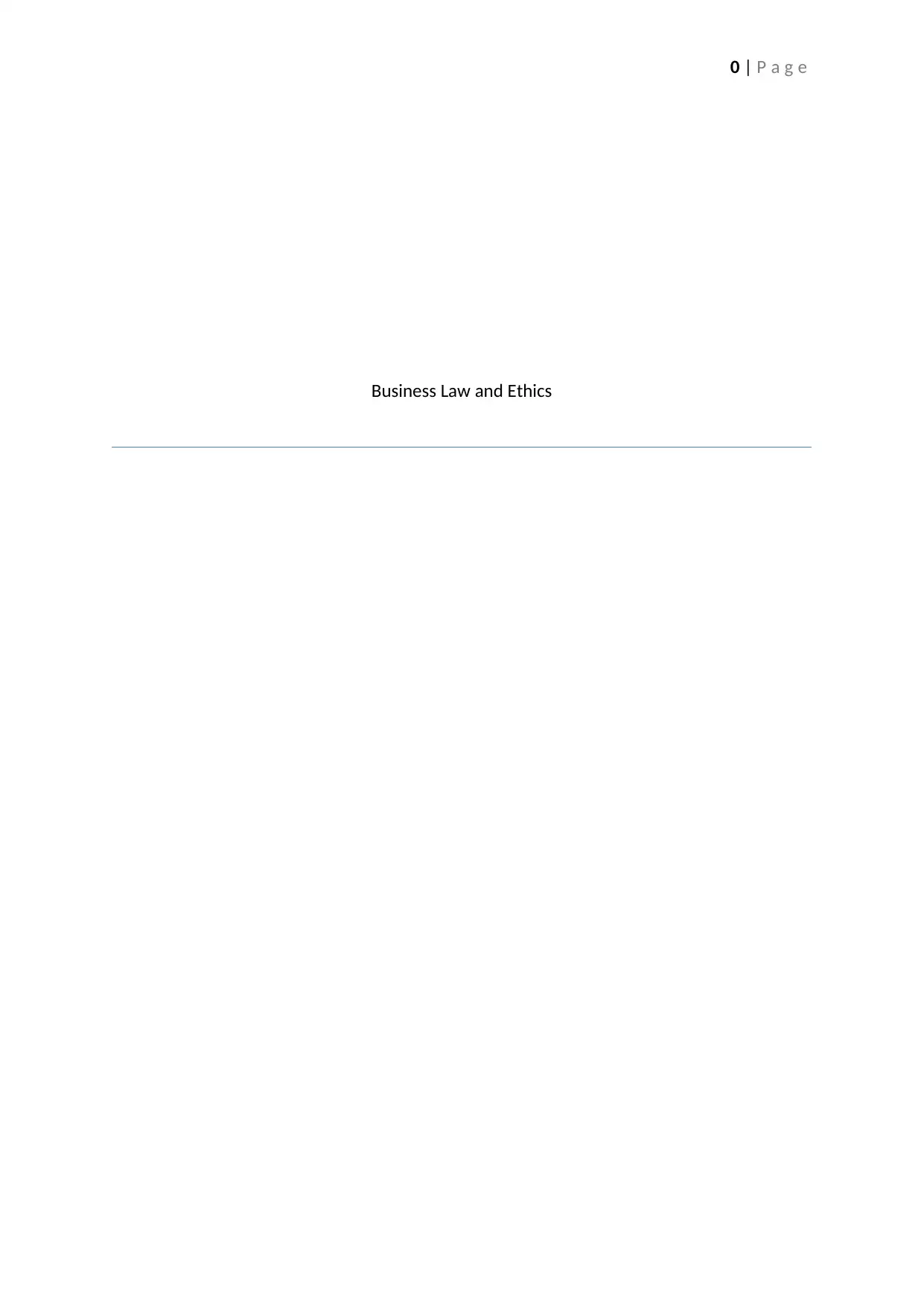
0 | P a g e
Business Law and Ethics
Business Law and Ethics
Paraphrase This Document
Need a fresh take? Get an instant paraphrase of this document with our AI Paraphraser
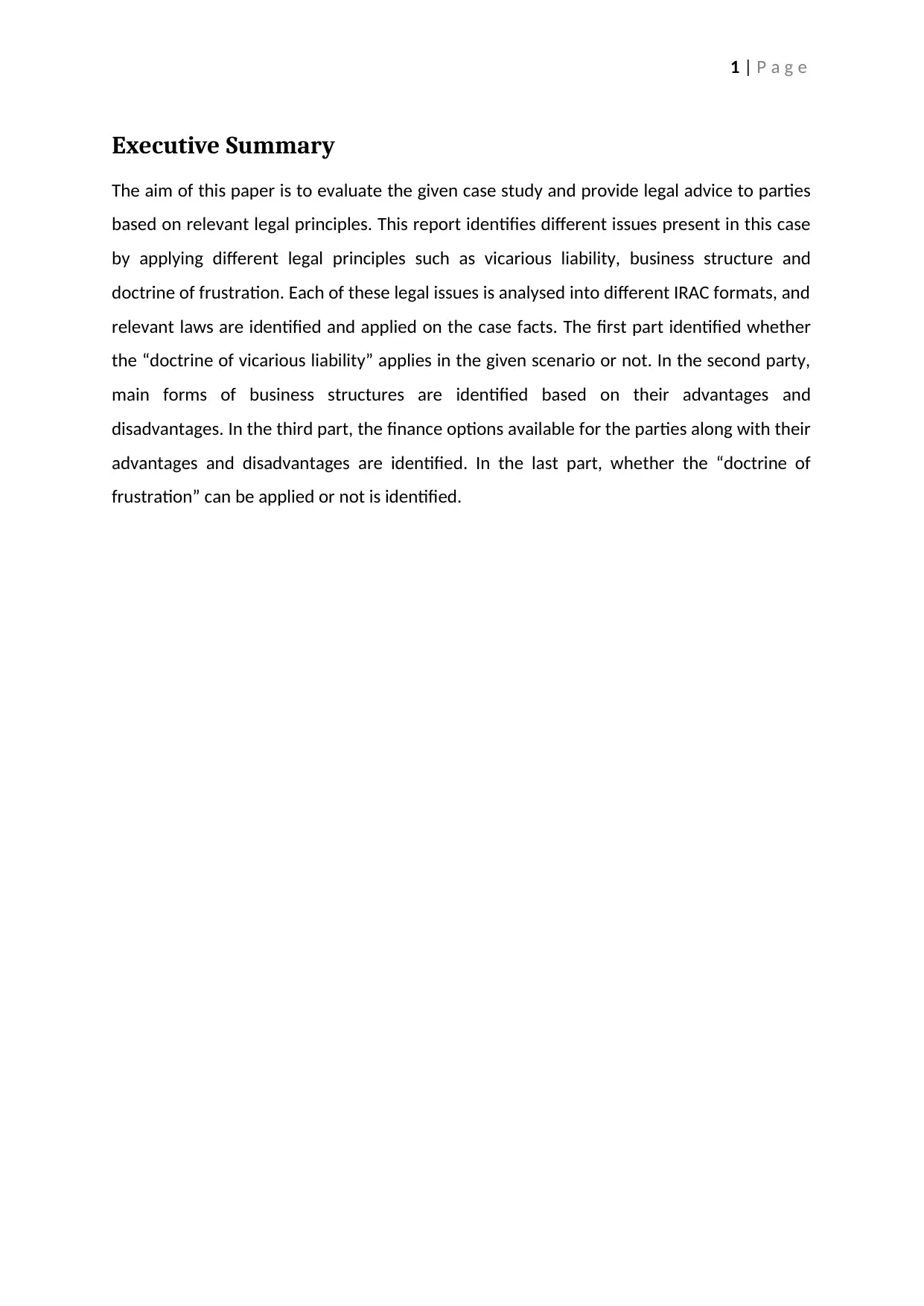
1 | P a g e
Executive Summary
The aim of this paper is to evaluate the given case study and provide legal advice to parties
based on relevant legal principles. This report identifies different issues present in this case
by applying different legal principles such as vicarious liability, business structure and
doctrine of frustration. Each of these legal issues is analysed into different IRAC formats, and
relevant laws are identified and applied on the case facts. The first part identified whether
the “doctrine of vicarious liability” applies in the given scenario or not. In the second party,
main forms of business structures are identified based on their advantages and
disadvantages. In the third part, the finance options available for the parties along with their
advantages and disadvantages are identified. In the last part, whether the “doctrine of
frustration” can be applied or not is identified.
Executive Summary
The aim of this paper is to evaluate the given case study and provide legal advice to parties
based on relevant legal principles. This report identifies different issues present in this case
by applying different legal principles such as vicarious liability, business structure and
doctrine of frustration. Each of these legal issues is analysed into different IRAC formats, and
relevant laws are identified and applied on the case facts. The first part identified whether
the “doctrine of vicarious liability” applies in the given scenario or not. In the second party,
main forms of business structures are identified based on their advantages and
disadvantages. In the third part, the finance options available for the parties along with their
advantages and disadvantages are identified. In the last part, whether the “doctrine of
frustration” can be applied or not is identified.
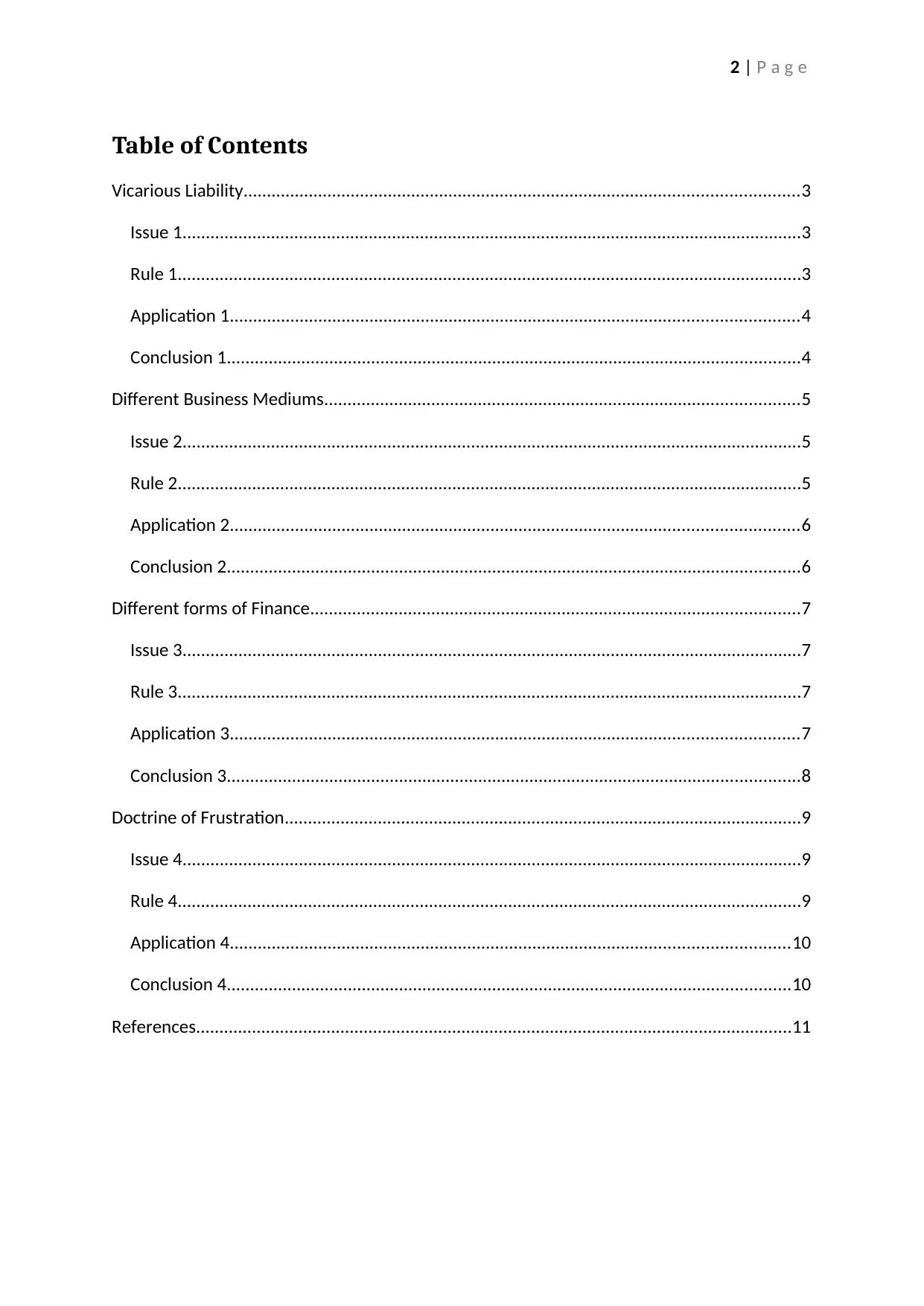
2 | P a g e
Table of Contents
Vicarious Liability.......................................................................................................................3
Issue 1.....................................................................................................................................3
Rule 1......................................................................................................................................3
Application 1..........................................................................................................................4
Conclusion 1...........................................................................................................................4
Different Business Mediums......................................................................................................5
Issue 2.....................................................................................................................................5
Rule 2......................................................................................................................................5
Application 2..........................................................................................................................6
Conclusion 2...........................................................................................................................6
Different forms of Finance.........................................................................................................7
Issue 3.....................................................................................................................................7
Rule 3......................................................................................................................................7
Application 3..........................................................................................................................7
Conclusion 3...........................................................................................................................8
Doctrine of Frustration...............................................................................................................9
Issue 4.....................................................................................................................................9
Rule 4......................................................................................................................................9
Application 4........................................................................................................................10
Conclusion 4.........................................................................................................................10
References................................................................................................................................11
Table of Contents
Vicarious Liability.......................................................................................................................3
Issue 1.....................................................................................................................................3
Rule 1......................................................................................................................................3
Application 1..........................................................................................................................4
Conclusion 1...........................................................................................................................4
Different Business Mediums......................................................................................................5
Issue 2.....................................................................................................................................5
Rule 2......................................................................................................................................5
Application 2..........................................................................................................................6
Conclusion 2...........................................................................................................................6
Different forms of Finance.........................................................................................................7
Issue 3.....................................................................................................................................7
Rule 3......................................................................................................................................7
Application 3..........................................................................................................................7
Conclusion 3...........................................................................................................................8
Doctrine of Frustration...............................................................................................................9
Issue 4.....................................................................................................................................9
Rule 4......................................................................................................................................9
Application 4........................................................................................................................10
Conclusion 4.........................................................................................................................10
References................................................................................................................................11
⊘ This is a preview!⊘
Do you want full access?
Subscribe today to unlock all pages.

Trusted by 1+ million students worldwide

3 | P a g e
Vicarious Liability
Issue 1
The key issue is whether the “doctrine of vicarious liability” applies in the case of Tiffany
while filling any proceedings against Jonathan and/or the bus company?
Rule 1
The principle of “vicarious liability” provides that one person will be held liable for the torts
of another despite the fact that the second person has not committed the tortious act
himself. This is referred to a “form of strict liability” in which the defendant is not at fault;
however, the court imposes liable on him for the actions taken by another person (Bell,
2013). One of the most common relationships in which this principle applies is the
employer-employee relationship. There are certain elements which must be present while
establishing the vicarious liability of the employer. The first element is that the person who
has committed the tort must be an employee of the defendant, which means that there
must be a relationship of control. In this regard, the “control test” can be used which was
identified in “Yewen v Noakes [1880] 6 QBD 530”. It evaluates whether the employer tells
the employee what to do and how to do it. “Integration test” is another option in which the
test asks if the person is integrated into the company.
The third test is “Economic reality test” which determines who pays the worker taxes or
insurance or provide them the tool of work (Kotecha, 2014). The second element is the
establishment of a tortious act which must be committed by the employee. The third
element is that the torts which are committed “during the course of employment”. In the
case of “Limpus v London General Omnibus Company (1862) 158 ER 993”, strict instructions
were given to the bus driver to not obstruct the drivers of the rival company; however, he
did not follow the instruction which results in an accident (Magnet, 2015). The court
imposed the liability on the employer by providing that the principle of vicarious liability
applies despite the fact that the employer has strictly prohibited the wrongful action taken
by the driver. However, the court did not impose the liability on the employer in the case of
“Iqbal v London Transport Executive [1973] EWCA Civ 3” in which a conductor disobeyed the
Vicarious Liability
Issue 1
The key issue is whether the “doctrine of vicarious liability” applies in the case of Tiffany
while filling any proceedings against Jonathan and/or the bus company?
Rule 1
The principle of “vicarious liability” provides that one person will be held liable for the torts
of another despite the fact that the second person has not committed the tortious act
himself. This is referred to a “form of strict liability” in which the defendant is not at fault;
however, the court imposes liable on him for the actions taken by another person (Bell,
2013). One of the most common relationships in which this principle applies is the
employer-employee relationship. There are certain elements which must be present while
establishing the vicarious liability of the employer. The first element is that the person who
has committed the tort must be an employee of the defendant, which means that there
must be a relationship of control. In this regard, the “control test” can be used which was
identified in “Yewen v Noakes [1880] 6 QBD 530”. It evaluates whether the employer tells
the employee what to do and how to do it. “Integration test” is another option in which the
test asks if the person is integrated into the company.
The third test is “Economic reality test” which determines who pays the worker taxes or
insurance or provide them the tool of work (Kotecha, 2014). The second element is the
establishment of a tortious act which must be committed by the employee. The third
element is that the torts which are committed “during the course of employment”. In the
case of “Limpus v London General Omnibus Company (1862) 158 ER 993”, strict instructions
were given to the bus driver to not obstruct the drivers of the rival company; however, he
did not follow the instruction which results in an accident (Magnet, 2015). The court
imposed the liability on the employer by providing that the principle of vicarious liability
applies despite the fact that the employer has strictly prohibited the wrongful action taken
by the driver. However, the court did not impose the liability on the employer in the case of
“Iqbal v London Transport Executive [1973] EWCA Civ 3” in which a conductor disobeyed the
Paraphrase This Document
Need a fresh take? Get an instant paraphrase of this document with our AI Paraphraser
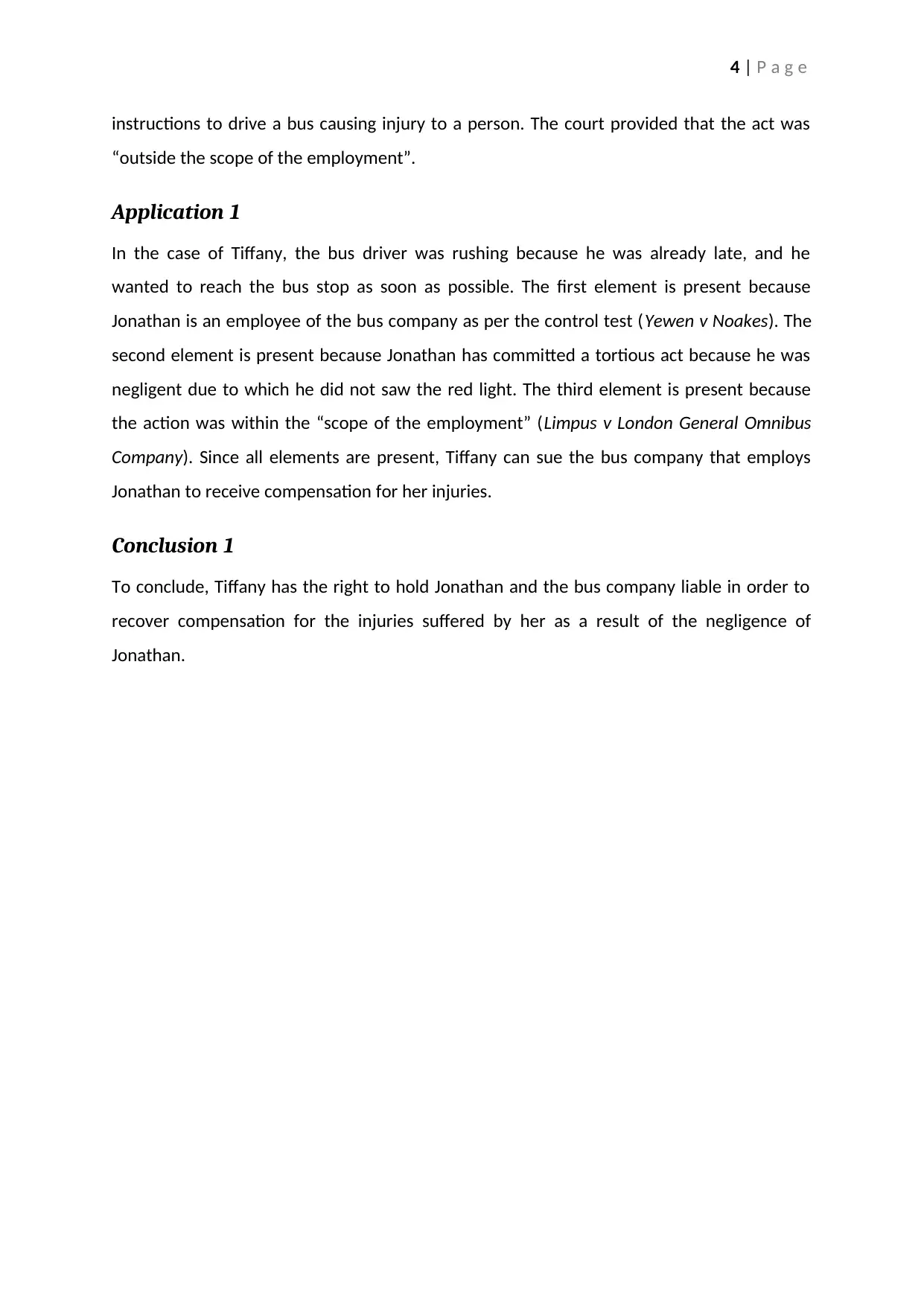
4 | P a g e
instructions to drive a bus causing injury to a person. The court provided that the act was
“outside the scope of the employment”.
Application 1
In the case of Tiffany, the bus driver was rushing because he was already late, and he
wanted to reach the bus stop as soon as possible. The first element is present because
Jonathan is an employee of the bus company as per the control test (Yewen v Noakes). The
second element is present because Jonathan has committed a tortious act because he was
negligent due to which he did not saw the red light. The third element is present because
the action was within the “scope of the employment” (Limpus v London General Omnibus
Company). Since all elements are present, Tiffany can sue the bus company that employs
Jonathan to receive compensation for her injuries.
Conclusion 1
To conclude, Tiffany has the right to hold Jonathan and the bus company liable in order to
recover compensation for the injuries suffered by her as a result of the negligence of
Jonathan.
instructions to drive a bus causing injury to a person. The court provided that the act was
“outside the scope of the employment”.
Application 1
In the case of Tiffany, the bus driver was rushing because he was already late, and he
wanted to reach the bus stop as soon as possible. The first element is present because
Jonathan is an employee of the bus company as per the control test (Yewen v Noakes). The
second element is present because Jonathan has committed a tortious act because he was
negligent due to which he did not saw the red light. The third element is present because
the action was within the “scope of the employment” (Limpus v London General Omnibus
Company). Since all elements are present, Tiffany can sue the bus company that employs
Jonathan to receive compensation for her injuries.
Conclusion 1
To conclude, Tiffany has the right to hold Jonathan and the bus company liable in order to
recover compensation for the injuries suffered by her as a result of the negligence of
Jonathan.
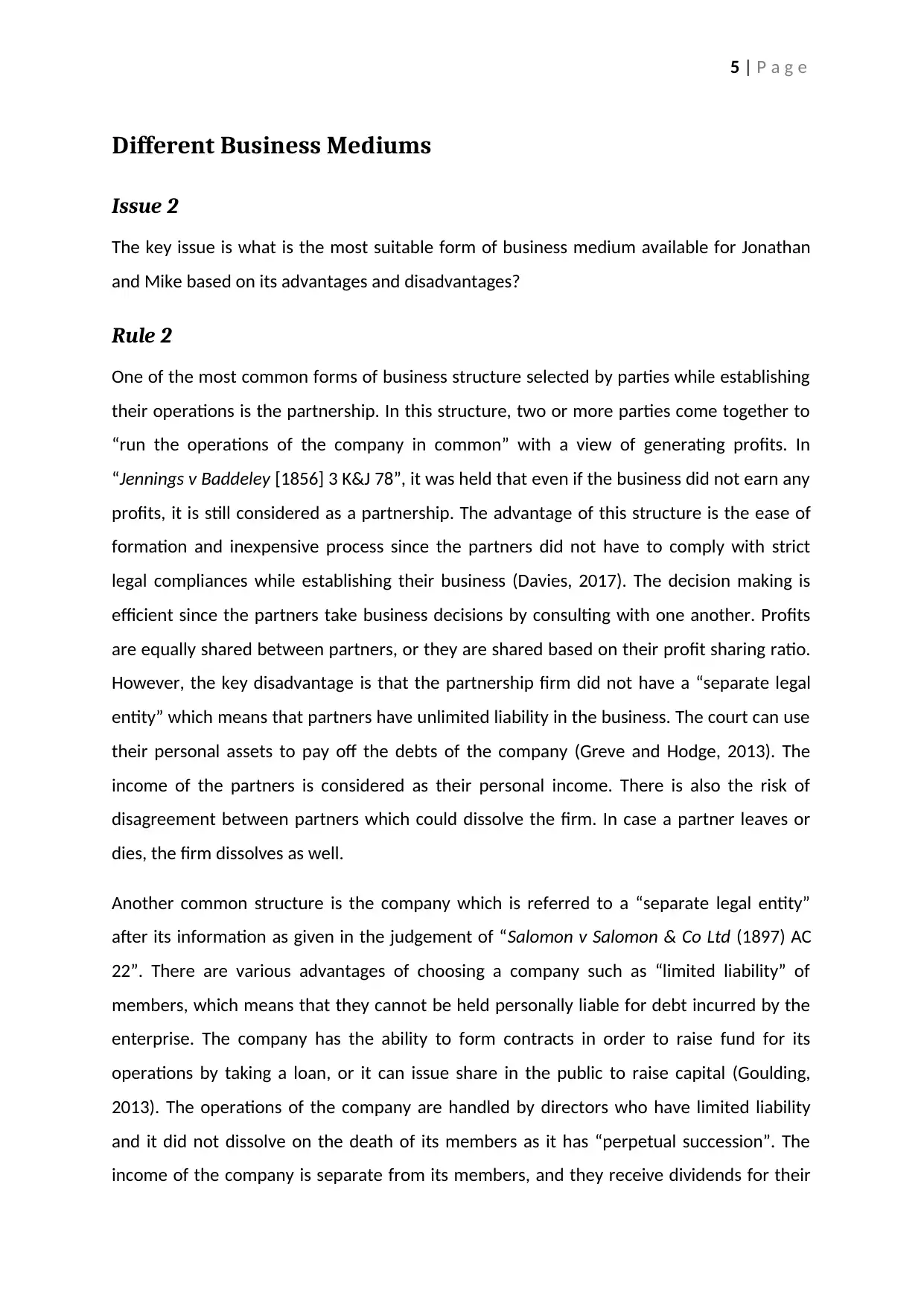
5 | P a g e
Different Business Mediums
Issue 2
The key issue is what is the most suitable form of business medium available for Jonathan
and Mike based on its advantages and disadvantages?
Rule 2
One of the most common forms of business structure selected by parties while establishing
their operations is the partnership. In this structure, two or more parties come together to
“run the operations of the company in common” with a view of generating profits. In
“Jennings v Baddeley [1856] 3 K&J 78”, it was held that even if the business did not earn any
profits, it is still considered as a partnership. The advantage of this structure is the ease of
formation and inexpensive process since the partners did not have to comply with strict
legal compliances while establishing their business (Davies, 2017). The decision making is
efficient since the partners take business decisions by consulting with one another. Profits
are equally shared between partners, or they are shared based on their profit sharing ratio.
However, the key disadvantage is that the partnership firm did not have a “separate legal
entity” which means that partners have unlimited liability in the business. The court can use
their personal assets to pay off the debts of the company (Greve and Hodge, 2013). The
income of the partners is considered as their personal income. There is also the risk of
disagreement between partners which could dissolve the firm. In case a partner leaves or
dies, the firm dissolves as well.
Another common structure is the company which is referred to a “separate legal entity”
after its information as given in the judgement of “Salomon v Salomon & Co Ltd (1897) AC
22”. There are various advantages of choosing a company such as “limited liability” of
members, which means that they cannot be held personally liable for debt incurred by the
enterprise. The company has the ability to form contracts in order to raise fund for its
operations by taking a loan, or it can issue share in the public to raise capital (Goulding,
2013). The operations of the company are handled by directors who have limited liability
and it did not dissolve on the death of its members as it has “perpetual succession”. The
income of the company is separate from its members, and they receive dividends for their
Different Business Mediums
Issue 2
The key issue is what is the most suitable form of business medium available for Jonathan
and Mike based on its advantages and disadvantages?
Rule 2
One of the most common forms of business structure selected by parties while establishing
their operations is the partnership. In this structure, two or more parties come together to
“run the operations of the company in common” with a view of generating profits. In
“Jennings v Baddeley [1856] 3 K&J 78”, it was held that even if the business did not earn any
profits, it is still considered as a partnership. The advantage of this structure is the ease of
formation and inexpensive process since the partners did not have to comply with strict
legal compliances while establishing their business (Davies, 2017). The decision making is
efficient since the partners take business decisions by consulting with one another. Profits
are equally shared between partners, or they are shared based on their profit sharing ratio.
However, the key disadvantage is that the partnership firm did not have a “separate legal
entity” which means that partners have unlimited liability in the business. The court can use
their personal assets to pay off the debts of the company (Greve and Hodge, 2013). The
income of the partners is considered as their personal income. There is also the risk of
disagreement between partners which could dissolve the firm. In case a partner leaves or
dies, the firm dissolves as well.
Another common structure is the company which is referred to a “separate legal entity”
after its information as given in the judgement of “Salomon v Salomon & Co Ltd (1897) AC
22”. There are various advantages of choosing a company such as “limited liability” of
members, which means that they cannot be held personally liable for debt incurred by the
enterprise. The company has the ability to form contracts in order to raise fund for its
operations by taking a loan, or it can issue share in the public to raise capital (Goulding,
2013). The operations of the company are handled by directors who have limited liability
and it did not dissolve on the death of its members as it has “perpetual succession”. The
income of the company is separate from its members, and they receive dividends for their
⊘ This is a preview!⊘
Do you want full access?
Subscribe today to unlock all pages.

Trusted by 1+ million students worldwide
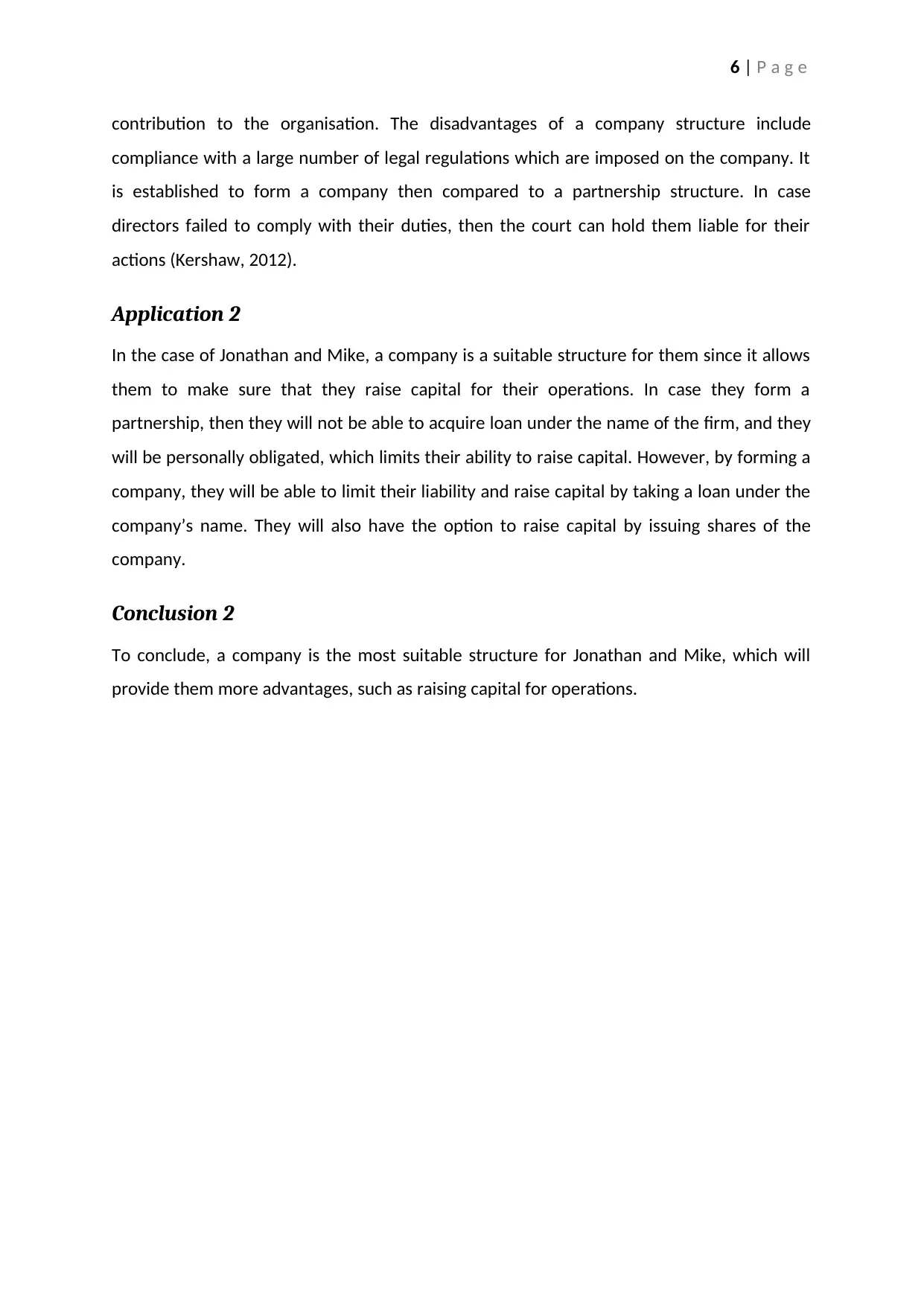
6 | P a g e
contribution to the organisation. The disadvantages of a company structure include
compliance with a large number of legal regulations which are imposed on the company. It
is established to form a company then compared to a partnership structure. In case
directors failed to comply with their duties, then the court can hold them liable for their
actions (Kershaw, 2012).
Application 2
In the case of Jonathan and Mike, a company is a suitable structure for them since it allows
them to make sure that they raise capital for their operations. In case they form a
partnership, then they will not be able to acquire loan under the name of the firm, and they
will be personally obligated, which limits their ability to raise capital. However, by forming a
company, they will be able to limit their liability and raise capital by taking a loan under the
company’s name. They will also have the option to raise capital by issuing shares of the
company.
Conclusion 2
To conclude, a company is the most suitable structure for Jonathan and Mike, which will
provide them more advantages, such as raising capital for operations.
contribution to the organisation. The disadvantages of a company structure include
compliance with a large number of legal regulations which are imposed on the company. It
is established to form a company then compared to a partnership structure. In case
directors failed to comply with their duties, then the court can hold them liable for their
actions (Kershaw, 2012).
Application 2
In the case of Jonathan and Mike, a company is a suitable structure for them since it allows
them to make sure that they raise capital for their operations. In case they form a
partnership, then they will not be able to acquire loan under the name of the firm, and they
will be personally obligated, which limits their ability to raise capital. However, by forming a
company, they will be able to limit their liability and raise capital by taking a loan under the
company’s name. They will also have the option to raise capital by issuing shares of the
company.
Conclusion 2
To conclude, a company is the most suitable structure for Jonathan and Mike, which will
provide them more advantages, such as raising capital for operations.
Paraphrase This Document
Need a fresh take? Get an instant paraphrase of this document with our AI Paraphraser
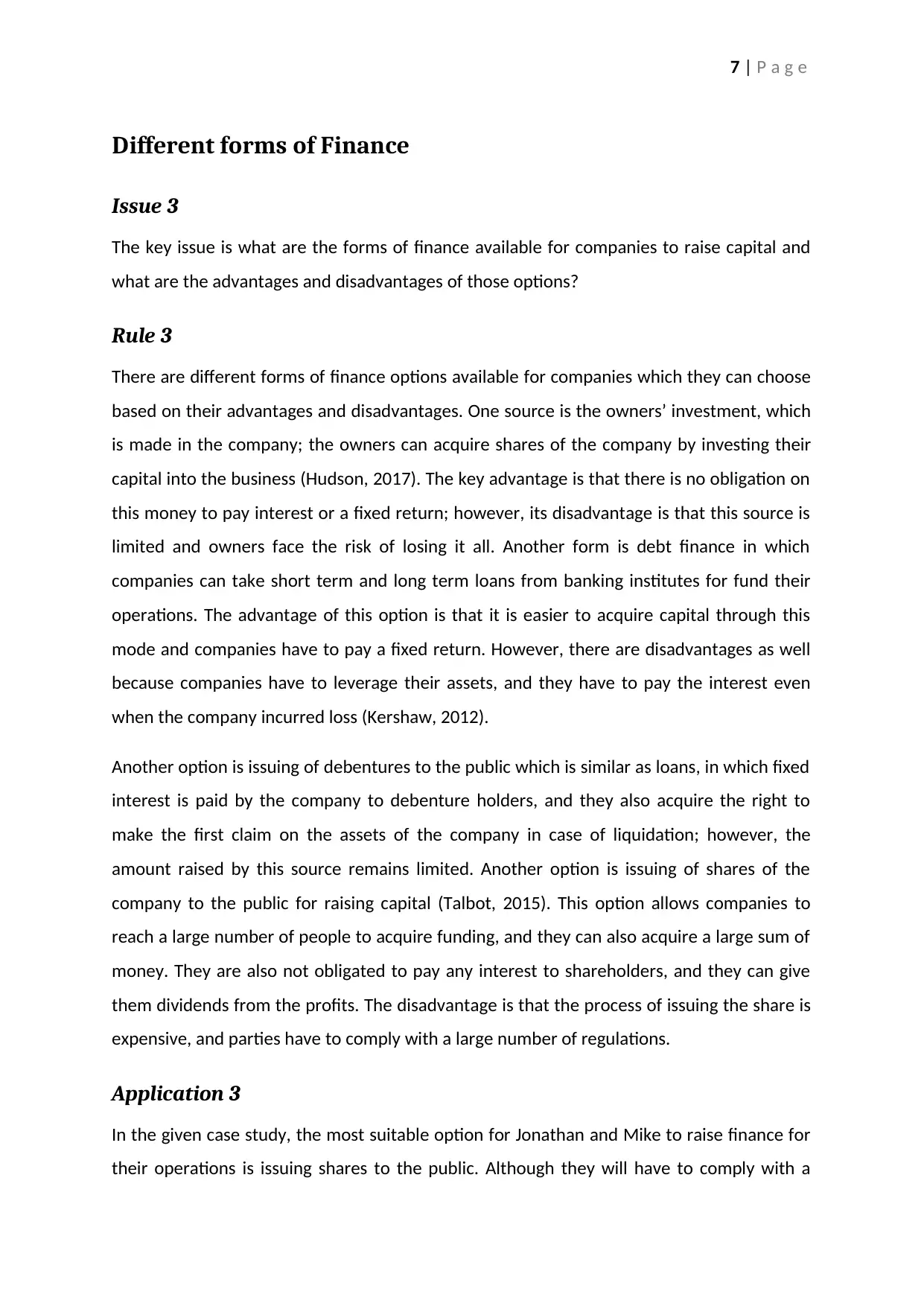
7 | P a g e
Different forms of Finance
Issue 3
The key issue is what are the forms of finance available for companies to raise capital and
what are the advantages and disadvantages of those options?
Rule 3
There are different forms of finance options available for companies which they can choose
based on their advantages and disadvantages. One source is the owners’ investment, which
is made in the company; the owners can acquire shares of the company by investing their
capital into the business (Hudson, 2017). The key advantage is that there is no obligation on
this money to pay interest or a fixed return; however, its disadvantage is that this source is
limited and owners face the risk of losing it all. Another form is debt finance in which
companies can take short term and long term loans from banking institutes for fund their
operations. The advantage of this option is that it is easier to acquire capital through this
mode and companies have to pay a fixed return. However, there are disadvantages as well
because companies have to leverage their assets, and they have to pay the interest even
when the company incurred loss (Kershaw, 2012).
Another option is issuing of debentures to the public which is similar as loans, in which fixed
interest is paid by the company to debenture holders, and they also acquire the right to
make the first claim on the assets of the company in case of liquidation; however, the
amount raised by this source remains limited. Another option is issuing of shares of the
company to the public for raising capital (Talbot, 2015). This option allows companies to
reach a large number of people to acquire funding, and they can also acquire a large sum of
money. They are also not obligated to pay any interest to shareholders, and they can give
them dividends from the profits. The disadvantage is that the process of issuing the share is
expensive, and parties have to comply with a large number of regulations.
Application 3
In the given case study, the most suitable option for Jonathan and Mike to raise finance for
their operations is issuing shares to the public. Although they will have to comply with a
Different forms of Finance
Issue 3
The key issue is what are the forms of finance available for companies to raise capital and
what are the advantages and disadvantages of those options?
Rule 3
There are different forms of finance options available for companies which they can choose
based on their advantages and disadvantages. One source is the owners’ investment, which
is made in the company; the owners can acquire shares of the company by investing their
capital into the business (Hudson, 2017). The key advantage is that there is no obligation on
this money to pay interest or a fixed return; however, its disadvantage is that this source is
limited and owners face the risk of losing it all. Another form is debt finance in which
companies can take short term and long term loans from banking institutes for fund their
operations. The advantage of this option is that it is easier to acquire capital through this
mode and companies have to pay a fixed return. However, there are disadvantages as well
because companies have to leverage their assets, and they have to pay the interest even
when the company incurred loss (Kershaw, 2012).
Another option is issuing of debentures to the public which is similar as loans, in which fixed
interest is paid by the company to debenture holders, and they also acquire the right to
make the first claim on the assets of the company in case of liquidation; however, the
amount raised by this source remains limited. Another option is issuing of shares of the
company to the public for raising capital (Talbot, 2015). This option allows companies to
reach a large number of people to acquire funding, and they can also acquire a large sum of
money. They are also not obligated to pay any interest to shareholders, and they can give
them dividends from the profits. The disadvantage is that the process of issuing the share is
expensive, and parties have to comply with a large number of regulations.
Application 3
In the given case study, the most suitable option for Jonathan and Mike to raise finance for
their operations is issuing shares to the public. Although they will have to comply with a
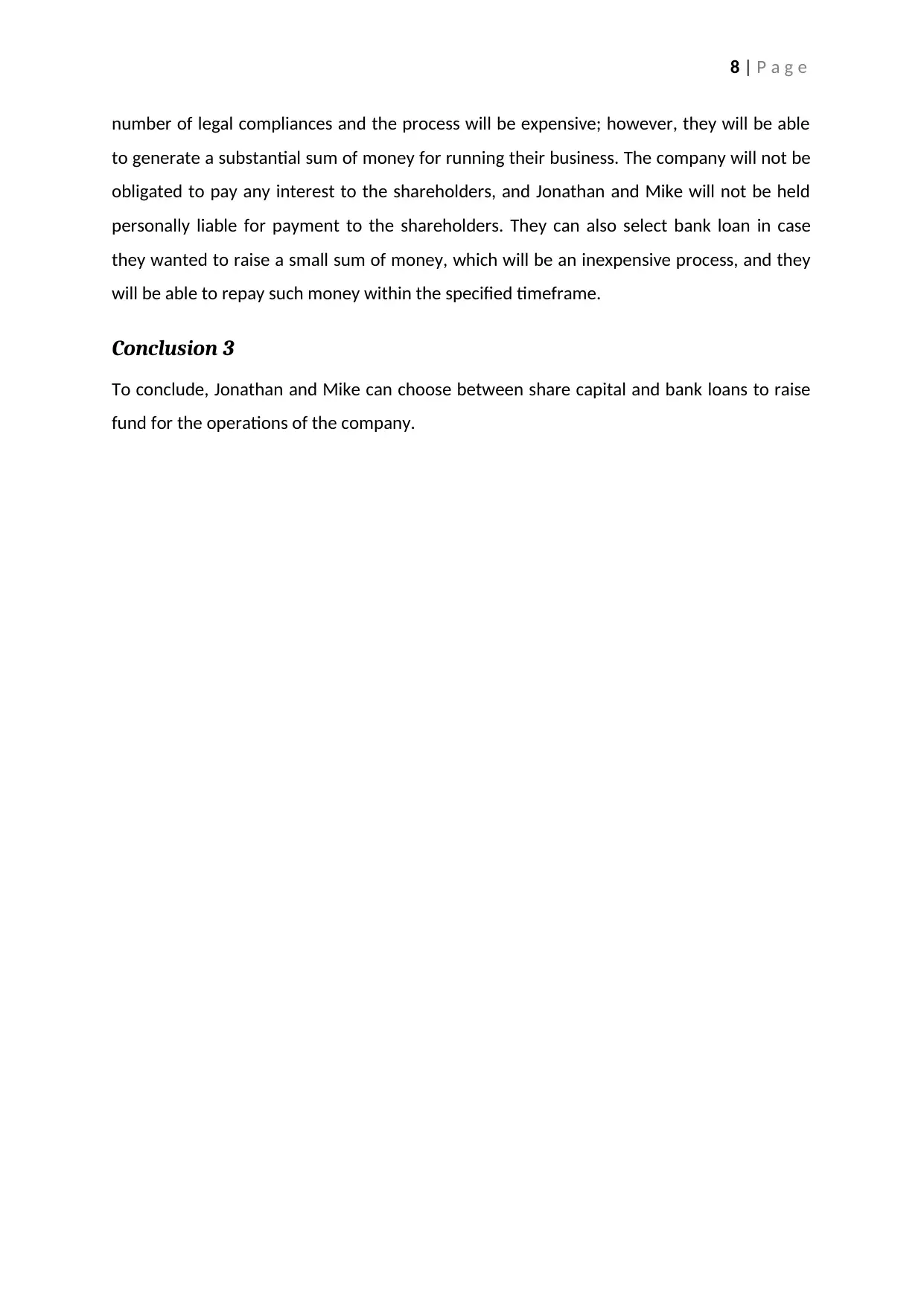
8 | P a g e
number of legal compliances and the process will be expensive; however, they will be able
to generate a substantial sum of money for running their business. The company will not be
obligated to pay any interest to the shareholders, and Jonathan and Mike will not be held
personally liable for payment to the shareholders. They can also select bank loan in case
they wanted to raise a small sum of money, which will be an inexpensive process, and they
will be able to repay such money within the specified timeframe.
Conclusion 3
To conclude, Jonathan and Mike can choose between share capital and bank loans to raise
fund for the operations of the company.
number of legal compliances and the process will be expensive; however, they will be able
to generate a substantial sum of money for running their business. The company will not be
obligated to pay any interest to the shareholders, and Jonathan and Mike will not be held
personally liable for payment to the shareholders. They can also select bank loan in case
they wanted to raise a small sum of money, which will be an inexpensive process, and they
will be able to repay such money within the specified timeframe.
Conclusion 3
To conclude, Jonathan and Mike can choose between share capital and bank loans to raise
fund for the operations of the company.
⊘ This is a preview!⊘
Do you want full access?
Subscribe today to unlock all pages.

Trusted by 1+ million students worldwide
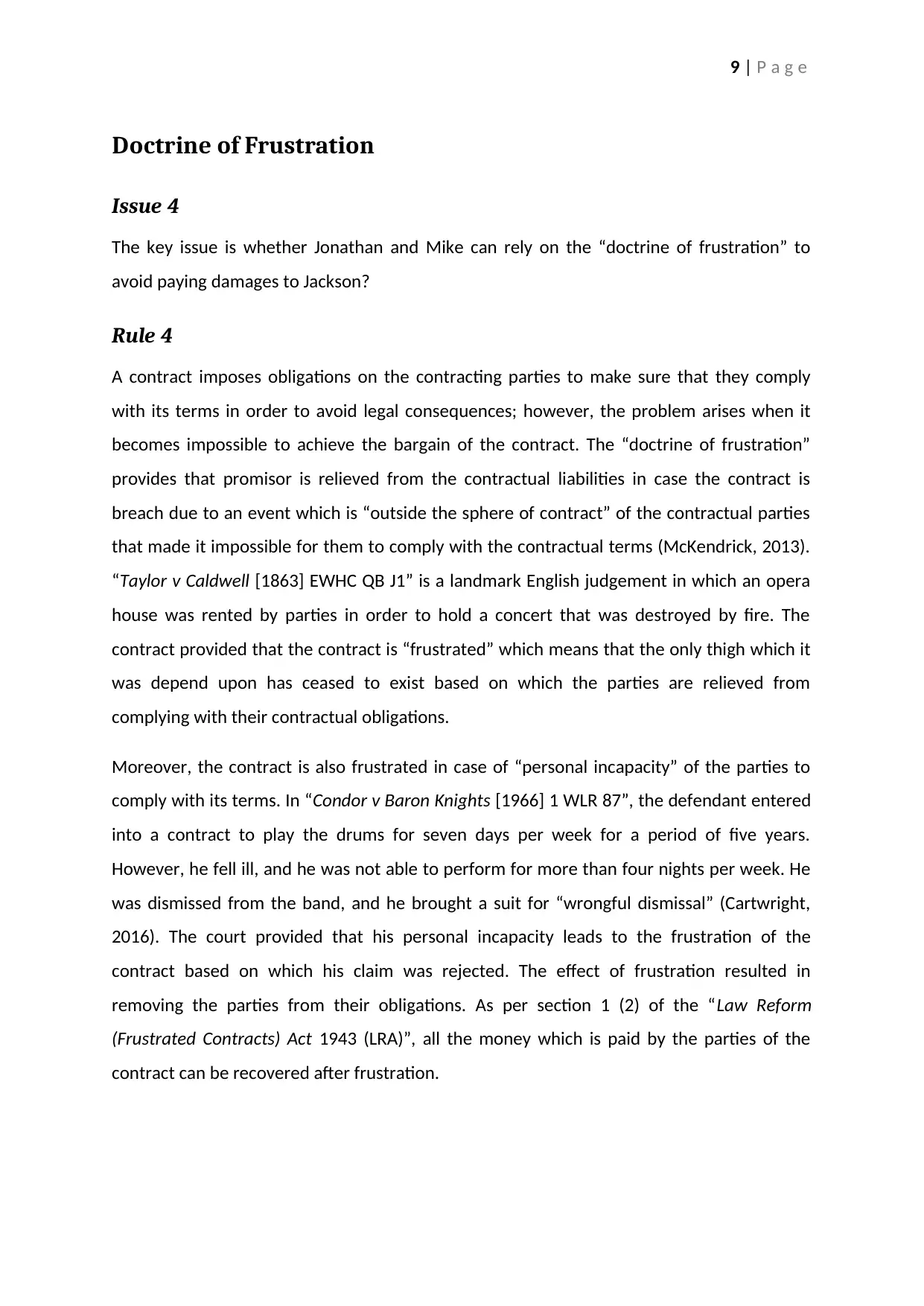
9 | P a g e
Doctrine of Frustration
Issue 4
The key issue is whether Jonathan and Mike can rely on the “doctrine of frustration” to
avoid paying damages to Jackson?
Rule 4
A contract imposes obligations on the contracting parties to make sure that they comply
with its terms in order to avoid legal consequences; however, the problem arises when it
becomes impossible to achieve the bargain of the contract. The “doctrine of frustration”
provides that promisor is relieved from the contractual liabilities in case the contract is
breach due to an event which is “outside the sphere of contract” of the contractual parties
that made it impossible for them to comply with the contractual terms (McKendrick, 2013).
“Taylor v Caldwell [1863] EWHC QB J1” is a landmark English judgement in which an opera
house was rented by parties in order to hold a concert that was destroyed by fire. The
contract provided that the contract is “frustrated” which means that the only thigh which it
was depend upon has ceased to exist based on which the parties are relieved from
complying with their contractual obligations.
Moreover, the contract is also frustrated in case of “personal incapacity” of the parties to
comply with its terms. In “Condor v Baron Knights [1966] 1 WLR 87”, the defendant entered
into a contract to play the drums for seven days per week for a period of five years.
However, he fell ill, and he was not able to perform for more than four nights per week. He
was dismissed from the band, and he brought a suit for “wrongful dismissal” (Cartwright,
2016). The court provided that his personal incapacity leads to the frustration of the
contract based on which his claim was rejected. The effect of frustration resulted in
removing the parties from their obligations. As per section 1 (2) of the “Law Reform
(Frustrated Contracts) Act 1943 (LRA)”, all the money which is paid by the parties of the
contract can be recovered after frustration.
Doctrine of Frustration
Issue 4
The key issue is whether Jonathan and Mike can rely on the “doctrine of frustration” to
avoid paying damages to Jackson?
Rule 4
A contract imposes obligations on the contracting parties to make sure that they comply
with its terms in order to avoid legal consequences; however, the problem arises when it
becomes impossible to achieve the bargain of the contract. The “doctrine of frustration”
provides that promisor is relieved from the contractual liabilities in case the contract is
breach due to an event which is “outside the sphere of contract” of the contractual parties
that made it impossible for them to comply with the contractual terms (McKendrick, 2013).
“Taylor v Caldwell [1863] EWHC QB J1” is a landmark English judgement in which an opera
house was rented by parties in order to hold a concert that was destroyed by fire. The
contract provided that the contract is “frustrated” which means that the only thigh which it
was depend upon has ceased to exist based on which the parties are relieved from
complying with their contractual obligations.
Moreover, the contract is also frustrated in case of “personal incapacity” of the parties to
comply with its terms. In “Condor v Baron Knights [1966] 1 WLR 87”, the defendant entered
into a contract to play the drums for seven days per week for a period of five years.
However, he fell ill, and he was not able to perform for more than four nights per week. He
was dismissed from the band, and he brought a suit for “wrongful dismissal” (Cartwright,
2016). The court provided that his personal incapacity leads to the frustration of the
contract based on which his claim was rejected. The effect of frustration resulted in
removing the parties from their obligations. As per section 1 (2) of the “Law Reform
(Frustrated Contracts) Act 1943 (LRA)”, all the money which is paid by the parties of the
contract can be recovered after frustration.
Paraphrase This Document
Need a fresh take? Get an instant paraphrase of this document with our AI Paraphraser
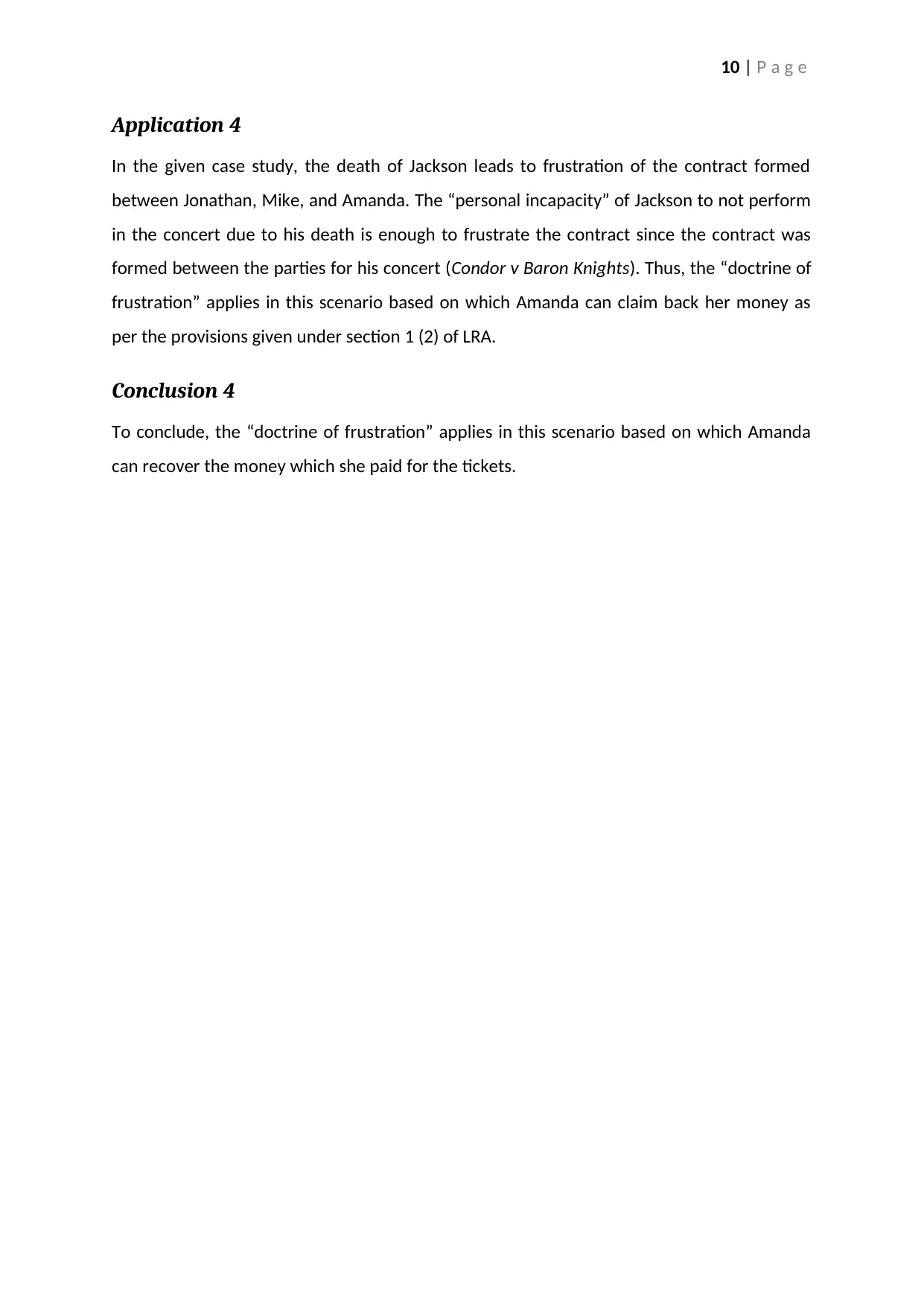
10 | P a g e
Application 4
In the given case study, the death of Jackson leads to frustration of the contract formed
between Jonathan, Mike, and Amanda. The “personal incapacity” of Jackson to not perform
in the concert due to his death is enough to frustrate the contract since the contract was
formed between the parties for his concert (Condor v Baron Knights). Thus, the “doctrine of
frustration” applies in this scenario based on which Amanda can claim back her money as
per the provisions given under section 1 (2) of LRA.
Conclusion 4
To conclude, the “doctrine of frustration” applies in this scenario based on which Amanda
can recover the money which she paid for the tickets.
Application 4
In the given case study, the death of Jackson leads to frustration of the contract formed
between Jonathan, Mike, and Amanda. The “personal incapacity” of Jackson to not perform
in the concert due to his death is enough to frustrate the contract since the contract was
formed between the parties for his concert (Condor v Baron Knights). Thus, the “doctrine of
frustration” applies in this scenario based on which Amanda can claim back her money as
per the provisions given under section 1 (2) of LRA.
Conclusion 4
To conclude, the “doctrine of frustration” applies in this scenario based on which Amanda
can recover the money which she paid for the tickets.
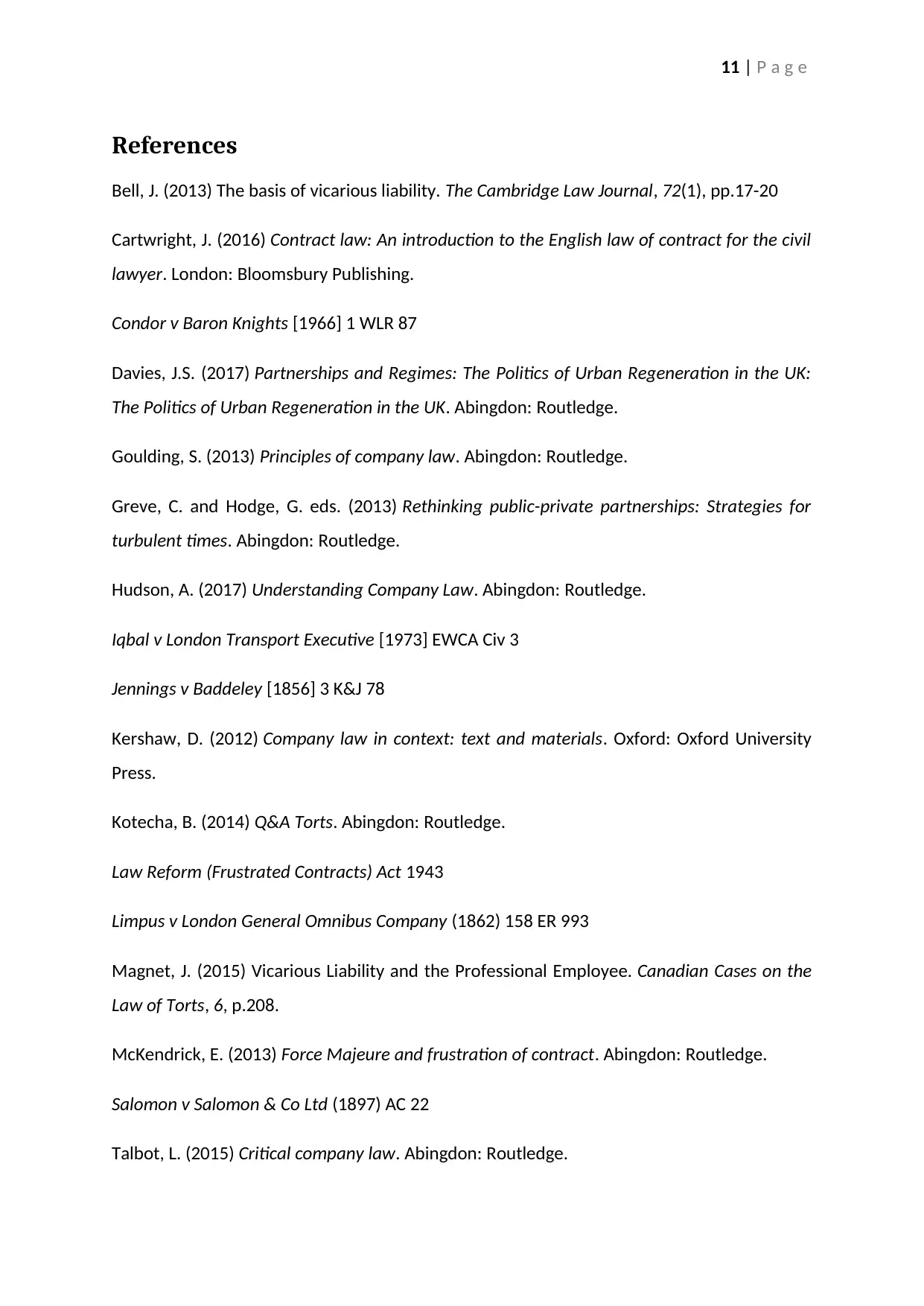
11 | P a g e
References
Bell, J. (2013) The basis of vicarious liability. The Cambridge Law Journal, 72(1), pp.17-20
Cartwright, J. (2016) Contract law: An introduction to the English law of contract for the civil
lawyer. London: Bloomsbury Publishing.
Condor v Baron Knights [1966] 1 WLR 87
Davies, J.S. (2017) Partnerships and Regimes: The Politics of Urban Regeneration in the UK:
The Politics of Urban Regeneration in the UK. Abingdon: Routledge.
Goulding, S. (2013) Principles of company law. Abingdon: Routledge.
Greve, C. and Hodge, G. eds. (2013) Rethinking public-private partnerships: Strategies for
turbulent times. Abingdon: Routledge.
Hudson, A. (2017) Understanding Company Law. Abingdon: Routledge.
Iqbal v London Transport Executive [1973] EWCA Civ 3
Jennings v Baddeley [1856] 3 K&J 78
Kershaw, D. (2012) Company law in context: text and materials. Oxford: Oxford University
Press.
Kotecha, B. (2014) Q&A Torts. Abingdon: Routledge.
Law Reform (Frustrated Contracts) Act 1943
Limpus v London General Omnibus Company (1862) 158 ER 993
Magnet, J. (2015) Vicarious Liability and the Professional Employee. Canadian Cases on the
Law of Torts, 6, p.208.
McKendrick, E. (2013) Force Majeure and frustration of contract. Abingdon: Routledge.
Salomon v Salomon & Co Ltd (1897) AC 22
Talbot, L. (2015) Critical company law. Abingdon: Routledge.
References
Bell, J. (2013) The basis of vicarious liability. The Cambridge Law Journal, 72(1), pp.17-20
Cartwright, J. (2016) Contract law: An introduction to the English law of contract for the civil
lawyer. London: Bloomsbury Publishing.
Condor v Baron Knights [1966] 1 WLR 87
Davies, J.S. (2017) Partnerships and Regimes: The Politics of Urban Regeneration in the UK:
The Politics of Urban Regeneration in the UK. Abingdon: Routledge.
Goulding, S. (2013) Principles of company law. Abingdon: Routledge.
Greve, C. and Hodge, G. eds. (2013) Rethinking public-private partnerships: Strategies for
turbulent times. Abingdon: Routledge.
Hudson, A. (2017) Understanding Company Law. Abingdon: Routledge.
Iqbal v London Transport Executive [1973] EWCA Civ 3
Jennings v Baddeley [1856] 3 K&J 78
Kershaw, D. (2012) Company law in context: text and materials. Oxford: Oxford University
Press.
Kotecha, B. (2014) Q&A Torts. Abingdon: Routledge.
Law Reform (Frustrated Contracts) Act 1943
Limpus v London General Omnibus Company (1862) 158 ER 993
Magnet, J. (2015) Vicarious Liability and the Professional Employee. Canadian Cases on the
Law of Torts, 6, p.208.
McKendrick, E. (2013) Force Majeure and frustration of contract. Abingdon: Routledge.
Salomon v Salomon & Co Ltd (1897) AC 22
Talbot, L. (2015) Critical company law. Abingdon: Routledge.
⊘ This is a preview!⊘
Do you want full access?
Subscribe today to unlock all pages.

Trusted by 1+ million students worldwide
1 out of 13
Related Documents
Your All-in-One AI-Powered Toolkit for Academic Success.
+13062052269
info@desklib.com
Available 24*7 on WhatsApp / Email
![[object Object]](/_next/static/media/star-bottom.7253800d.svg)
Unlock your academic potential
Copyright © 2020–2025 A2Z Services. All Rights Reserved. Developed and managed by ZUCOL.




